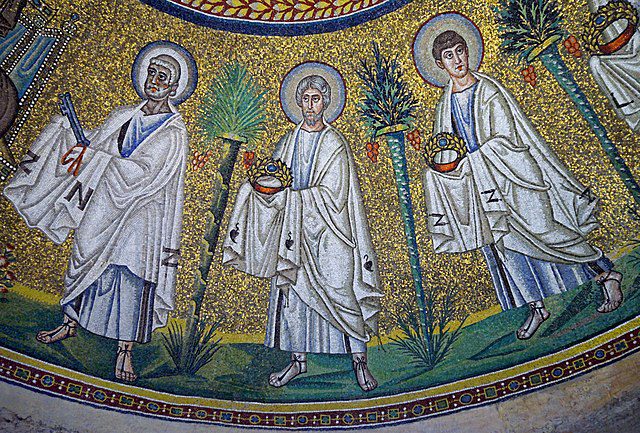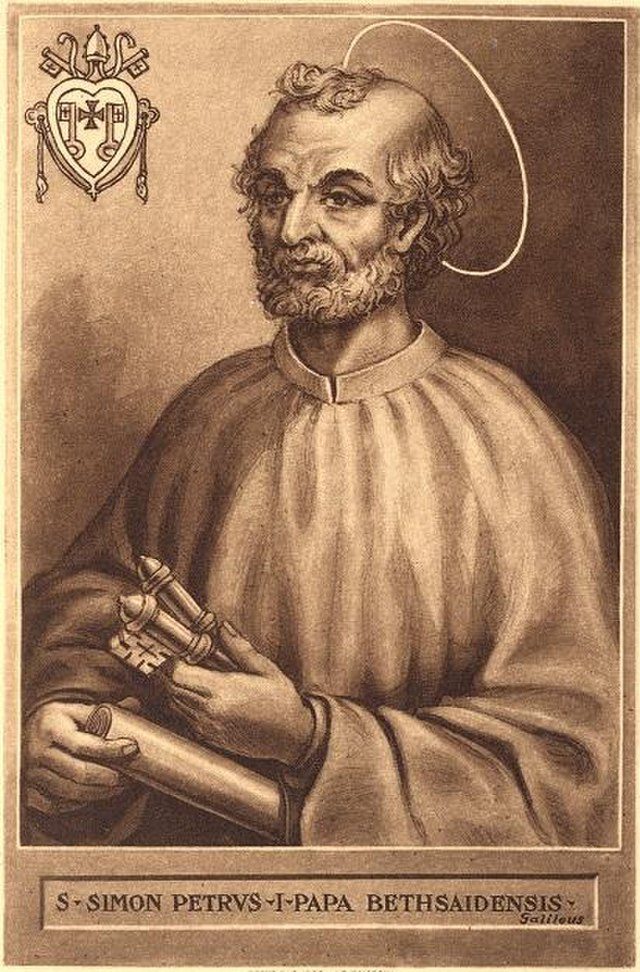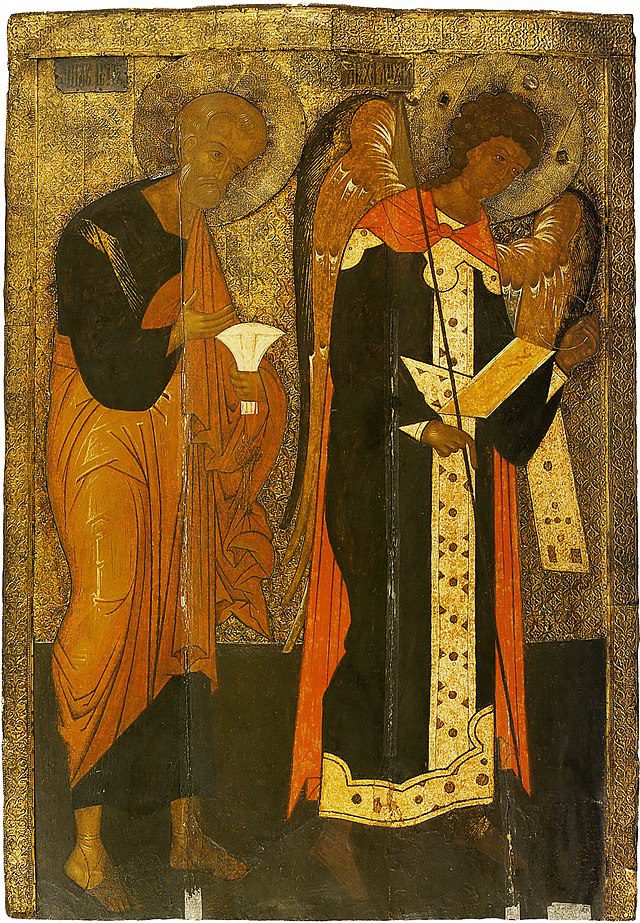Top 15 Amazing Facts about Saint Peter
Originally published by Lilian on May 2021 and updated by Charity K on August 2022 and Updated by Vanessa R on June 2023. Updated by Ruth in March 2024.
Saint Peter who was also known as Simon Peter, and was called Cephas by Jesus, was one of the 12 disciples. He was also one of the first leaders of the early church.
He was born in Bethsaida and grew up to be a fisherman together with his brother Andrew. People knew him as Simeon, this was his Hebrew name.
One thing that stood out about St. Peter was his character. He was described as being rash and hasty while sometimes he was short-tempered.
In some instances, Peter was said to be gentle but firm. He loved Jesus and proved to be loyal. Unlike Paul, Peter only spoke Hebrew and had to learn Greek.
Later on, Peter became the patron saints of Popes and Rome. Many cities around the world bear his names such as St. Petersburg in Russia and St. Peter’s Square in Rome.
It is also believed that he holds the keys to heaven. There is more about St. Peter, read them in the facts below.
1. Peter was crucified upside down

By Giuseppe Cesari – Wikimedia
Peter was crucified in Rome by Emperor Nero who accused Christians of the Rome fire in year 64. He ordered the crucifixion of all Christians.
St. Peter was crucified in Nero’s Circus which was near Vatican Hill. This exact location is where the Vatican is located, hence the name of the church St. Peter’s Basilica.
His final request before crucifixion was to be crucified upside down. This was because he felt he was not worth being crucified upright like Jesus.
His death had been predicted by Jesus; Jesus had told him that he will die a martyr.
2. Peter was the first Pope
Peter was considered to be the first Pope of Rome. According to the Eastern Christian church, he was also the first patriarch of Antioch.
He was revered as the founder of the Church of Antioch. Peter became the Bishop of the Diocese of Rome. Jesus had promised Peter a special position in the church.
Peter first met Jesus while listening to a sermon by John the Baptist. Immediately, Peter knew he was the messiah. Jesus called him the Rock, meaning he would be the foundation of the church.
3. Peter was a fisherman

By Duccio di Buoninsegna – Wikimedia
Peter grew up in Bethsaida and was a fisherman together with his younger brother Andrew. They used to dish together with James and John who were the sons of Zebedee.
One incident that was reported in the bible was when they caught more fish than they usually did. This was after they had spent the night in the sea and caught nothing.
Jesus had instructed them to cast their nets on the opposite side. After their big catch, Peter left everything and followed Jesus.
He was called the fishers of men by Jesus, a practice which he went back to after Jesus was resurrected.
Jesus used to preach on the boat that Peter owned.
4. There is a Church on the same foundation as St. Peter’s House
There is a Franciscan church built on the foundation of the hose that belonged to St Peter.
Archaeologists believe that the town was not an urban one, but a small fishing village. The remains from the site indicate that the town was not large and not that significant.
They also reported that there was a church at Bethsaida that had been built over Peter and Andrew’s house. The church had been built around the year 725.
5. Peter’s Basilica is named after him

By Alvesgaspar – Wikimedia
The original Saint Peter’s Basilica was commissioned by Constantine I around 324. It was at this Basilica that Charlemagne was crowned the emperor of the Holy Roman Empire.
This church existed between the 4th and16th centuries. It is the current location of Vatican City. The church was damaged during the Arab raid against Rome in 846.
They plundered the outskirts of the city of Rome while sacking the basilicas of Old St Peter’s and St Paul’s-Outside-the-Walls.
Although there is little evidence of the original Basilica, archaeologists found a piece of mosaic from the 8th century.
6. As a disciple, he was named Cephas by Jesus
According to the gospel of John, he wrote that when Jesus met Simo Peter, he immediately called him Cephas. This name means rock in Aramaic, a language that Jesus spoke.
During those days, the people were given nicknames according to their character. Peter’s nickname was very important and prophetic as well.
Jesus also predicted Peter’s death saying he would be persecuted. However, throughout the bible, Peter is not referred to as Cephas, but by his birth name Simon Peter.
7. His character was the most outstanding of all the 12 disciples

By Giuseppe Cesari – Wikimedia
One of the most interesting disciples of Jesus was Peter. He was the most outspoken, assertive and loyal. He loved Jesus and was very dedicated to spreading the gospel.
Peter was also very inquisitive and did not hesitate to ask questions he did not understand. He always sought clarification.
8. St Peter was the leader of the 12 disciples

By Caravaggio – Wikimedia
Peter was not the leader of the disciples at the beginning. It is recorded that he was not educated and was not bilingual.
Greek was an important language in those days, and Peter had to learn the language. Although it took him time to learn, he eventually did and was given more responsibilities.
In the gospel books, Peter is referred to as the leader of the disciples. He was there in every important event and was always with Jesus.
It was Peter, James and John who were always included in important events such as the transfiguration that happened in Gethsemane.
Peter was also the spokesman of the disciples and took precedence over the others. This was probably because he was the most outspoken and was not afraid of asking questions.
9. Important Squares and churches were dedicated to St. Peter

By Alvesgaspar – Wikimedia
There are several churches and city squares all over the world named after St. Peter. In Vatican City, St. Peter’s Basilica has dedicated to him as well as the square in front of the church.
It is believed that he was crucified on a hill, now known as Vatican hill by Emperor Nero. This happened after the great fire of Rome. Emperor Nero accused the Christians of causing the fire. He persecuted the Christian community in the city.
Another city is St. Petersburg in Russia, it is a port city on the Baltic sea.
10. Peter died a martyr

By El Greco – Wikimedia
In the gospel book of John, Jesus told Peter he would be a martyr. He also described how he would die by stretching out his arms. Peter was crucified on the cross, but upside down.
An excavation done near St. Peter’s Basilica revealed bones believed to be of a male person. Further examination of the bones showed that he was about 60 years old.
Pope Paul VI later, in 1968, announced that the bones were possibly the remains of St. Peter.
Part of the relics was presented in public during mass at St. Peter’s Square.
11. Simon Peter’s Name appears many times in the New Testament

Photo by Wikimedia Commons – Wikimedia
In the New Testament, the name “Simon Peter” is found 19 times. He appears repeatedly and prominently in all four gospels as well as the Acts of the Apostles. The Gospel of Mark in particular was traditionally thought to show the influence of Peter’s preaching and eyewitness memories. He is also mentioned, under either the name Peter or Cephas, in Paul’s First Letter to the Corinthians and the Epistle to the Galatians.
12. Two Epistles in the New Testament Named after Peter

Photo by Wikimedia Commons – Wikimedia
The New Testament also includes two general epistles, First Peter and Second Peter, that are traditionally attributed to him, but modern scholarship generally rejects the Petrine authorship of both.
Nevertheless, Evangelicals and Catholics have always affirmed Peter’s authorship, and recently, a growing number of scholars have revived the claim of Petrine authorship of these epistles.
13. Many Apocryphal Books were Attributed to Peter

Photo by Wikimedia Commons – Wikimedia
Outside of the New Testament, several apocryphal books were later attributed to him, in particular, the Acts of Peter, Gospel of Peter, Preaching of Peter, Apocalypse of Peter, and Judgment of Peter, although scholars believe these works to be pseudepigrapha.
According to the Acts of the Apostles, Peter and John were sent from Jerusalem to Samaria (Acts 8:14). Peter/Cephas is mentioned briefly in the opening chapter of one of the Pauline epistles, Epistle to the Galatians, which mentions a trip by Paul the Apostle to Jerusalem where he meets Peter (Galatians 1:18). Peter features again in Galatians, fourteen years later, when Paul (now with Barnabas and Titus) returned to Jerusalem (Galatians 2:7–9). Galatians 2:7–When Peter came to Antioch, Paul opposed Peter to his face “because he [Peter] was in the wrong” (Galatians 2:11).
14. The Record of Peter’s Escape from Prison

Photo y by Wikimedia Commons – Wikimedia
The New Testament in Acts 12 talks about the Apostles. In addition, it records the death of the first apostle, James, son of Zebedee, followed by the miraculous escape of Peter from prison, the death of Herod Agrippa I, and the early ministry of Barnabas and Paul of Tarsus. The book containing this chapter is anonymous, but early Christian tradition uniformly affirmed that Luke composed this book as well as the Gospel of Luke.
15. Peter Surprised Believers When He Appeared to them at Rhoda’s House

Photo by Wikimedia Commons – Wikimedia
Peter’s reception by the church in this account has an element of humor that far from expecting their prayers to be answered, the believers are completely taken aback when Peter knocks at the door that the maid Rhoda (another minor character noted by Luke) runs back to the house instead of quickly open the door, so despite his supernatural escape, when prison doors were opened up for him, the house doors ‘remain obstinately closed’ for Peter.
St. Peter’s Most Memorable Quotes and Their Meaning
1. “You are the Christ, the Son of the living God.” (Matthew 16:16)
In this quote, Peter accepts Jesus’ divinity and recognises Him as the long-awaited Messiah. The passage stresses Peter’s acceptance of Jesus’ true nature and his trust in Him.
2. “Lord, if it is You, command me to come to You on the water.” (Matthew 14:28)
Peter’s boldness and determination to put his faith in Jesus in spite of difficult circumstances can be shown in his request to walk on water. It represents his desire to grow closer to Christ and take a leap of faith.
3. “But in your hearts honour Christ the Lord as holy, always being prepared to make a defence to anyone who asks you for a reason for the hope that is in you.” (1 Peter 3:15)
Peter urged Christians to live with a deep respect for Christ and to be prepared to explain their faith to others. It emphasises how crucial it is to be ready to articulate how a connection with Jesus inevitably leads to hope.
4. “Lord, to whom shall we go? You have the words of eternal life.” (John 6:68)
In making this declaration, Peter showed his unwavering faith in Jesus as the only way to find eternal salvation. His conviction that following Christ is the only path to meaningful life and fulfilment is emphasised by this.
Top 15 Facts about St. Peter’s Teachings
St. Peter, one of the twelve apostles of Jesus Christ and a prominent figure in early Christianity, played a crucial role in shaping the foundations of Christian doctrine through his teachings and writings. As a key disciple and a leader of the early Christian community, St. Peter’s teachings are primarily documented in the New Testament of the Bible, particularly in the Gospels and the Acts of the Apostles.
St. Peter’s teachings encompass a range of theological, ethical, and practical guidance for the nascent Christian community, emphasizing faith, love, and moral conduct. This article will explore some key aspects of St. Peter’s teachings, shedding light on his contributions to the development of Christian doctrine and the enduring impact of his words on the followers of Jesus.
1. St. Peter taught on the foundations of Christianity
St. Peter, recognized as one of the foundational figures of Christianity, played a pivotal role in shaping the early Christian Church. As one of the twelve apostles chosen by Jesus, he witnessed crucial events and teachings, contributing significantly to the establishment of Christian doctrine. St. Peter’s influence is particularly evident in his writings found in the New Testament, providing enduring guidance for believers and contributing to the theological foundation of Christianity.
2. St. Peter held a prominent leadership role among the apostles
St. Peter’s leadership role among the apostles was affirmed by Jesus, who famously declared, You are Peter, and on this rock, I will build my church (Matthew 16:18). This symbolic reference positioned St. Peter as a foundational figure upon whom the Christian Church would be established. His leadership extended beyond this metaphorical rock, as he emerged as a spokesperson for the apostles and a key figure in early Christian communities, guiding believers in their faith and practice.
3. St Peter was referred to as a fisher of men in the context of spreading the Christian faith

Saint Catherine Monastery, Public domain, via Wikimedia Commons
Originally a fisherman on the shores of the Sea of Galilee, St. Peter’s life took a transformative turn when he encountered Jesus. Responding to Jesus’ call to follow him, St. Peter abandoned his profession as a fisherman to become a devoted disciple and apostle. The symbolic transformation from a fisherman to a fisher of men underscored his new mission: to spread the message of Christ and gather believers into the fold of Christianity.
4. St. Peter witnessed Jesus’ transfiguration and his agony in the Garden of Gethsemane
St. Peter’s journey with Jesus included witnessing pivotal moments such as the Transfiguration and Jesus’ agony in the Garden of Gethsemane. However, his most poignant association with Jesus occurred during the events leading to the crucifixion. Despite his earlier declaration of unwavering loyalty, St. Peter famously denied knowing Jesus three times, fulfilling a prophecy made by Jesus himself. This moment of denial highlighted human frailty even among the closest followers of Jesus.
5. Following Jesus’ ascension, St. Peter played a key role in the Day of Pentecost

Duccio di Buoninsegna, Public domain, via Wikimedia Commons
After Jesus’ ascension, St. Peter played a central role in the transformative event of Pentecost. On this day, the Holy Spirit descended upon the apostles, empowering them with diverse languages and emboldening them to spread the Gospel. St. Peter emerged as a charismatic and influential speaker, addressing the crowds and proclaiming the message of Christ. This experience marked a significant turning point, as St. Peter and the apostles embarked on their mission to disseminate the teachings of Jesus, laying the groundwork for the early Christian Church.
6. St. Peter performed healing miracles
St. Peter’s ministry extended to performing healing miracles, exemplified by the notable incident at the Beautiful Gate in the Acts of the Apostles. The healing of a lame man underscored the apostles’ divine authority and the transformative power of faith in Jesus Christ.
7. St. Peter had significant visions which influenced the acceptance of Gentiles into the Christian community

Jacopo Tintoretto, Public domain, via Wikimedia Commons
St. Peter’s visions and revelations, including the vision of the sheet with unclean animals, were instrumental in shaping early Christian theology. The acceptance of Gentiles into the Christian community, influenced by these divine revelations, marked a significant expansion of the faith beyond its Jewish roots.
8. St. Peter is traditionally attributed with writing two books in the New Testament
Traditionally attributed to St. Peter, the Epistles of Peter (1 Peter and 2 Peter) are crucial contributions to the New Testament. These letters provide ethical and theological guidance to the early Christian communities, addressing challenges and reinforcing key principles of Christian living.
9. According to tradition, St. Peter was martyred in Rome during the reign of Emperor Nero

cjh1452000, CC BY-SA 3.0, via Wikimedia Commons
St. Peter’s martyrdom in Rome, where he was crucified upside down during Emperor Nero’s reign, stands as a testament to his unwavering commitment to the Christian faith. His willingness to face a brutal death reflects a profound sense of humility and devotion to Christ.
10. The Catholic Church considers St. Peter as its first pope
The Catholic Church considers St. Peter as its first pope, recognizing his foundational role in establishing the authority and leadership of the papacy. This connection underscores the enduring influence of St. Peter’s teachings on the ecclesiastical structure and governance of the Catholic Church.
11. The imagery of keys symbolizes authority in St. Peter’s teachings

Distant Shores Media/Sweet Publishing, CC BY-SA 3.0, via Wikimedia Commons
In the Gospel of Matthew, the imagery of keys becomes a powerful symbol of authority, underscoring St. Peter’s leadership role in the Christian Church. Jesus’ conferral of the keys to the kingdom of heaven is a profound act of entrustment, signifying St. Peter’s responsibility as a foundational figure in the establishment of the Christian faith. This symbolic gesture echoes the Old Testament, where keys were associated with the steward of a royal household, emphasizing St. Peter’s pivotal position in the unfolding narrative of Christianity.
12. St. Peter’s famous confession of faith is recorded in the Gospel of Matthew
St. Peter’s famous confession of faith, documented in the Gospel of Matthew, is a landmark moment in Christian theology. Declaring Jesus to be the Christ, the Son of the living God, St. Peter articulates a foundational truth that resonates throughout Christian doctrine. This confession not only underscores St. Peter’s recognition of Jesus’ divinity but also establishes a fundamental creed for the Christian faith, emphasizing the centrality of Christ in the Christian narrative.
13. St. Peter played a central role in preaching and baptizing converts

Pietro da Cortona, Public domain, via Wikimedia Commons
The Acts of the Apostles vividly portrays St. Peter’s central role in preaching and baptizing converts, contributing significantly to the expansion of the early Christian community. His speeches, particularly on the Day of Pentecost, played a crucial part in communicating the message of Jesus Christ to diverse audiences. St. Peter’s involvement in baptism reflects the transformative nature of the Christian faith, marking the initiation of individuals into the community of believers.
14. St. Peter, along with other apostles, served as a witness to the resurrection of Jesus Christ
St. Peter, alongside other apostles, served as a firsthand witness to the resurrection of Jesus Christ, a cornerstone event in Christian theology. His testimony, attesting to the reality of Christ’s triumph over death, became a foundational element in shaping the Christian understanding of salvation and eternal life. As a resurrection witness, St. Peter’s role is integral to the Christian narrative, reinforcing the core tenet of faith in the risen Christ.
15. St. Peter’s teachings and actions have left an enduring legacy in Christianity

Peter Paul Rubens, Public domain, via Wikimedia Commons
St. Peter’s teachings and actions have left an indelible legacy in Christianity, profoundly impacting doctrinal beliefs, ecclesiastical structures, and the overall understanding of faith and discipleship within the Christian tradition. His leadership role among the apostles, coupled with significant events such as the conferral of keys and the confession of faith, has shaped the ecclesiastical authority of the papacy in the Catholic Church. St. Peter’s enduring legacy extends beyond his historical presence, influencing the theological fabric of Christianity and inspiring countless believers throughout the centuries.
Planning a trip to Paris ? Get ready !
These are Amazon’s best-selling travel products that you may need for coming to Paris.
Bookstore
- The best travel book : Rick Steves – Paris 2023 – Learn more here
- Fodor’s Paris 2024 – Learn more here
Travel Gear
- Venture Pal Lightweight Backpack – Learn more here
- Samsonite Winfield 2 28″ Luggage – Learn more here
- Swig Savvy’s Stainless Steel Insulated Water Bottle – Learn more here
Check Amazon’s best-seller list for the most popular travel accessories. We sometimes read this list just to find out what new travel products people are buying.











